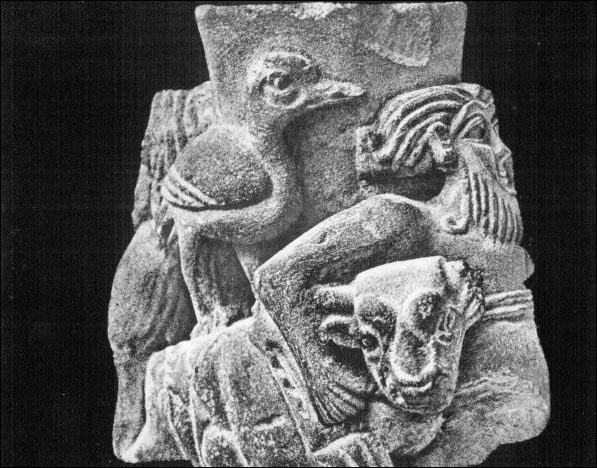 |
Origin The Ancient World : The Middle East : Proto-Literate Period Summary This limestone vase, serving possibly as a stand, gives us our earliest glimpse of what would become a well known subject of mythology: the bearded hero, the "lord of the animals," protecting the herds, battling off predators. He is the prototype of the muscular, athletic, aggressive, protective male, but here he is associated with the very forces of nature, including-presumably--the eagle Anzu bird. He is himself a force of nature, standing as a symbol of supernatural power, energy and benevolence. Flocks and herds were sacred to the goddess Inanna of Uruk, whence this vase came. Their care was a sacred, priestly responsibility. Description This limestone vase, from Uruk in southern Iraq along the banks of the Euphrates river, was purchased on the art market and came into the British Museum in 1927. It dates to the late 4th millennium B.C., and is representative of the late phase of the Uruk culture, the earliest period of the Sumerian culture. One of the earliest sculptures representing the human figure almost in the round, it depicts a curly-wavy haired, bearded hero, naked except for a belt, with his arms around the necks of two bulls. His face is remarkably expressive of a benevolent repose, confident of his protective powers over the cattle. The two bulls have their heads turned away from the hero, also in a gesture of repose. The male figure is repeated on the opposite side of the vase, with a heavier beard covering more of his face, with a more drawn, intense gaze, and with his arms draped around the bulls' buttocks. On either side of the vessel, above the bulls, one can see a simple bird. Some authorities interpret this bird as an early version of the eagle headed Anzu bird, who is often associated with cattle, both in protective and in menacing postures. Cultural Context One of the earliest scenes in the iconography of the Sumerian culture shows a muscular, curly haired, bearded lord of the animals, naked except for a belt, standing heraldically between two bulls, while next to him in the relief scene bull men struggle with lions. Scholars have long associated these figures with Gilgamesh and his friend Enkidu of the Gilgamesh Epic. Whether or not these identifications are correct, we have in any case in the vase the earliest representation of this deeply rooted cultural icon. Also in the Uruk period cylinder seals show a bearded priest feeding the herds and flocks of the goddess Inanna in her shrine in Uruk. The image on this vase therefore, and the vase itself, were sacral, ritual objects, conveying a message that must be understood within the context of the holy city of Uruk, its goddess Inanna, and its temples to her. The cattle are sacred animals, their care and protection is a sacred responsibility, requiring supernormal strength and powers, vested in a hero who is fitted out in all the symbols of power, virility, protectiveness and benevolence--all in honor of Inanna. The lord of the animals is also in many cultures a friend of the hunter, leading him to his prey, and meriting an offering in return. Here as in so many other aspects of ancient Near Eastern culture we see a symbiotic process at work, in which humans and animals interact within the same life system, guided from the top by deities and their representatives. The lord of the animals appears in various guises in many other cultures of the world. As this iconography developed over centuries of Mesopotamian culture, the successive heroes, masters of the animals, bull men, would of course be associated with other deities, the deities of the cities, whether in Mesopotamia itself or Syria, where they "served." He is assisted on the vase depicted here by a bird, presumably an early relief of the mythological Anzu bird, which is often pictured with its talons sinking into the backs of animals. This pose is also considered to be protective, although the Anzu bird was associated with ferocious and malevolent characteristics in other settings. References Parrot, Andre. Sumer, The Dawn of Art. Trans. by Stuart Gilbert and James Emmons. New York: Golden Press, 1961, p.78. Strommenger, Eva. 5000 Years of the Art of Mesopotamia. New York: Harry N. Abrams, Inc., n.d., pp.22, 385, 392. "Sumerian Stone Sculptured Vases." The British Museum Quarterly.2 (1927), pp.12-13. Zerries, Otto. "Lord of the Animals." Encyclopedia of Religion. Ed. by Mircea Elaide.9:22-26. |